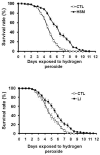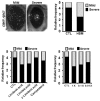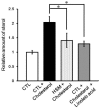The effects of hempseed meal intake and linoleic acid on Drosophila models of neurodegenerative diseases and hypercholesterolemia
- PMID: 21331775
- PMCID: PMC3933972
- DOI: 10.1007/s10059-011-0042-6
The effects of hempseed meal intake and linoleic acid on Drosophila models of neurodegenerative diseases and hypercholesterolemia
Abstract
Hempseed is rich in polyunsaturated fatty acids (PUFAs), which have potential as therapeutic compounds for the treatment of neurodegenerative and cardiovascular disease. However, the effect of hempseed meal (HSM) intake on the animal models of these diseases has yet to be elucidated. In this study, we assessed the effects of the intake of HSM and PUFAs on oxidative stress, cytotoxicity and neurological phenotypes, and cholesterol uptake, using Drosophila models. HSM intake was shown to reduce H(2)O(2) toxicity markedly, indicating that HSM exerts a profound antioxidant effect. Meanwhile, intake of HSM, as well as linoleic or linolenic acids (major PUFA components of HSM) was shown to ameliorate Aβ42-induced eye degeneration, thus suggesting that these compounds exert a protective effect against Aβ42 cytotoxicity. On the contrary, locomotion and longevity in the Parkinson's disease model and eye degeneration in the Huntington's disease model were unaffected by HSM feeding. Additionally, intake of HSM or linoleic acid was shown to reduce cholesterol uptake significantly. Moreover, linoleic acid intake has been shown to delay pupariation, and cholesterol feeding rescued the linoleic acid-induced larval growth delay, thereby indicating that linoleic acid acts antagonistically with cholesterol during larval growth. In conclusion, our results indicate that HSM and linoleic acid exert inhibitory effects on both Aβ42 cytotoxicity and cholesterol uptake, and are potential candidates for the treatment of Alzheimer's disease and cardiovascular disease.
Figures





Similar articles
-
Dietary hempseed meal intake increases body growth and shortens the larval stage via the upregulation of cell growth and sterol levels in Drosophila melanogaster.Mol Cells. 2010 Jul;30(1):29-36. doi: 10.1007/s10059-010-0085-0. Epub 2010 Jul 14. Mol Cells. 2010. PMID: 20652493
-
The flavonoid derivative 2-(4' Benzyloxyphenyl)-3-hydroxy-chromen-4-one protects against Aβ42-induced neurodegeneration in transgenic Drosophila: insights from in silico and in vivo studies.Neurotox Res. 2014 Nov;26(4):331-50. doi: 10.1007/s12640-014-9466-z. Epub 2014 Apr 5. Neurotox Res. 2014. PMID: 24706035
-
Cholesterol-induced stimulation of platelet aggregation is prevented by a hempseed-enriched diet.Can J Physiol Pharmacol. 2008 Apr;86(4):153-9. doi: 10.1139/Y08-011. Can J Physiol Pharmacol. 2008. PMID: 18418423
-
Omega-3 fatty acids and antioxidants in edible wild plants.Biol Res. 2004;37(2):263-77. doi: 10.4067/s0716-97602004000200013. Biol Res. 2004. PMID: 15455656 Review.
-
Drosophila models of Alzheimer's amyloidosis: the challenge of dissecting the complex mechanisms of toxicity of amyloid-beta 42.J Alzheimers Dis. 2008 Dec;15(4):523-40. doi: 10.3233/jad-2008-15402. J Alzheimers Dis. 2008. PMID: 19096154 Review.
Cited by
-
Phenotypic differences between Drosophila Alzheimer's disease models expressing human Aβ42 in the developing eye and brain.Anim Cells Syst (Seoul). 2017 Apr 15;21(3):160-168. doi: 10.1080/19768354.2017.1313777. eCollection 2017. Anim Cells Syst (Seoul). 2017. PMID: 30460065 Free PMC article.
-
Hemp Seed Fermented by Aspergillus oryzae Attenuates Lipopolysaccharide-Stimulated Inflammatory Responses in N9 Microglial Cells.Foods. 2022 Jun 9;11(12):1689. doi: 10.3390/foods11121689. Foods. 2022. PMID: 35741887 Free PMC article.
-
A network pharmacology-based approach to decipher the pharmacological mechanisms of Salvia officinalis in neurodegenerative disorders.Metab Brain Dis. 2025 Apr 23;40(5):190. doi: 10.1007/s11011-025-01599-6. Metab Brain Dis. 2025. PMID: 40266402
-
Extract of Fructus Cannabis Ameliorates Learning and Memory Impairment Induced by D-Galactose in an Aging Rats Model.Evid Based Complement Alternat Med. 2017;2017:4757520. doi: 10.1155/2017/4757520. Epub 2017 Oct 19. Evid Based Complement Alternat Med. 2017. PMID: 29234402 Free PMC article.
-
Antioxidant Properties of Hemp Proteins: From Functional Food to Phytotherapy and Beyond.Molecules. 2022 Nov 16;27(22):7924. doi: 10.3390/molecules27227924. Molecules. 2022. PMID: 36432024 Free PMC article. Review.
References
-
- Al-Khalifa A., Maddaford T.G., Chahine M.N. Effect of dietary hempseed intake on cardiac ischemia-reperfusion injury. American journal of physiology. Am. J. Physiol. Regul. Integr. Comp. Physiol. (2007);292:1198–1203. - PubMed
-
- Alvaro A., Rosales R., Masana L., Vallvé J.C. Polyunsaturated fatty acids down-regulate in vitro expression of the key intestinal cholesterol absorption protein NPC1L1: no effect of monounsaturated nor saturated fatty acids. J. Nutr. Biochem. (2010);21:518–525. - PubMed
-
- Bouzidi N., Mekki K., Boukaddoum A., Dida N., Kaddous A., Bouchenak M. Effects of omega-3 polyunsaturated fatty-acid supplementation on redox status in chronic renal failure patients with dyslipidemia. J. Ren. Nutr. (2010);5:321–328. - PubMed
-
- Callaway J.C. Hempseed as a nutritional resource: an overview. Euphytica. (2004);140:65–72.
-
- Callaway J., Schwab U., Harvima I., Halonen P., Mykkänen O., Hyvönen P., Järvinen T. Efficacy of dietary hempseed oil in patients with atopic dermatitis. J. Dermatolog. Treat. (2005);16:87–94. - PubMed
Publication types
MeSH terms
Substances
LinkOut - more resources
Full Text Sources
Medical
Molecular Biology Databases

